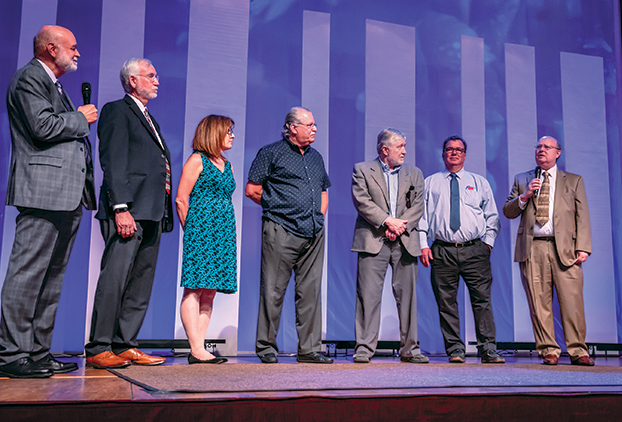A hospital building’s impact on a community and on the world was the theme of a 50th anniversary celebration of the opening of Loma Linda University Medical Center’s current cloverleaf structure. The program took place in the Loma Linda University Church, Sunday, Aug. 27.
“The decision to construct the current hospital building and consolidate medical education on this campus is one of the most significant events in this institution’s history,” said Richard Hart, MD, DrPH, president of Loma Linda University Health.
In the early 1960s, Loma Linda University faced demand from accrediting bodies that the medical school combine the two years of science education and the two years of clinical education onto one campus. At the time, Loma Linda University had taught science courses on the Loma Linda campus, while the clinical rotations took place in Los Angeles. The Board of Trustees settled on combining the two programs in Loma Linda.
The cloverleaf-shaped towers have become a Loma Linda icon. But as important as the building itself has been, clinical treatment innovations developed at the Medical Center have gone on to change how health care is delivered internationally.
Medical transformations discovered at Loma Linda
Those developments include:
• Proton therapy for cancer treatment — The vision of James Slater, MD, led him to find a way to minimize damage to healthy tissue while attacking cancer sites with radiation.
• Coronary angiography — Melvin Judkins, MD, developed the tools and techniques to revolutionize the approach to cardiac medicine. Judkins invented three types of catheters that are now used by coronary care physicians internationally.
• Perinatal research — Lawrence Longo, MD, brought together researchers from various medical and scientific disciplines to study hypoxia and its effect on fetal development. Over 40 years, researchers have moved from relatively simple theories to now looking at genetic modification ideas.
• Fetal heart monitoring — Edward Hon, MD, began a residency at White Memorial Medical Center in 1961 after study at Yale University. His work in developing technological solutions to monitoring fetal heart rates has led to dramatic improvements in obstetrical care around the world.
• Infant heart transplantation — Leonard Bailey, MD, was searching for transplantation techniques that might be used to save babies lives. Bailey’s research included the concept of cross species transplantation, which was ultimately attempted in the Baby Fae case. With the support of the institution, Bailey transplanted a baboon heart into an infant girl known publicly only as Baby Fae. About a year later, Bailey performed the first infant-to-infant heart transplant.
A new hospital
Loma Linda University Health is now constructing a new medical complex to meet the community’s needs and feature the best in seismic safety.
While the cost difference between the two projects is striking — $22 million for the current building and $1.5 billion for the new construction — the goal for Loma Linda University Medical Center remains the same: to continue the teaching and healing ministry of Jesus Christ.
Vision 2020 – The Campaign for a Whole Tomorrow is a comprehensive campaign that was launched to support a transformational vision for education and research, wholeness and clinical care including the new adult hospital and expanded Children’s Hospital construction project.
“We are blessed by the outpouring of support for Vision 2020,” Hart said. “In just a short time we have raised over $267 million toward our $360 million goal.
To view a video of the anniversary program and learn how to get involved with Vision 2020, visit lluhvision2020.org.

